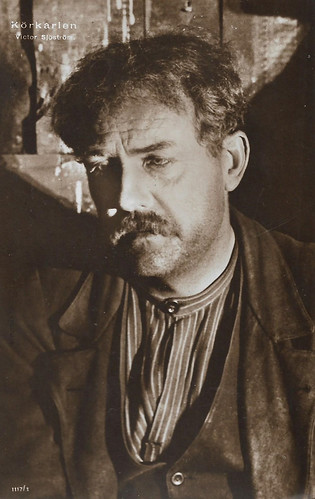
Swedish postcard by Förlag Nordisk Konst, Stockholm, no. 1117/1. Photo: Svensk Filmindustri. Victor Sjöström in Körkarlen/The Phantom Carriage (Victor Sjöström, 1921).

Swedish postcard by Förlag Nordisk Konst, Stockholm, no. 1117/2. Photo: Svensk Filmindustri. Astrid Holm in Körkarlen/The Phantom Carriage (Victor Sjöström, 1921).
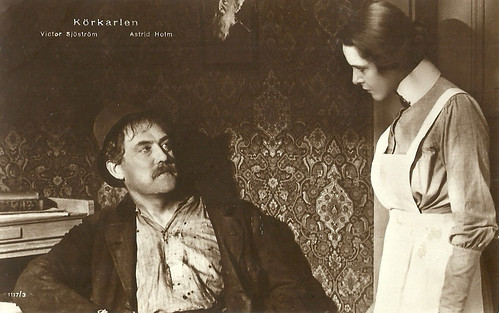
Swedish postcard by Förlag Nordisk Konst, Stockholm, no. 1117/3. Photo: Svensk Filmindustri. Victor Sjöström and Astrid Holm in Körkarlen/The Phantom Carriage (Victor Sjöström, 1921).
The legend of the Phantom Carriage
In Körkarlen/The Phantom Carriage (1920), the terminally ill Salvation Army nurse Edit (Astrid Holm) asks on New Year's Eve, her younger companions Maria (Lisa Lundholm) and Gustafsson (Tor Weijden) for one last wish: that they bring David Holm (Victor Sjöström) to her deathbed.
Meanwhile, David, a down-and-out alcoholic, gets drunk with two drinking buddies in a cemetery. He tells them about his former friend Georges (Tore Svennberg), who once told him the legend of the Phantom Carriage. This states that the last person to die in the old year is required by Death to collect the souls of the deceased in his carriage for the duration of the following year until the burden is transferred to a new person at the end of the year.
Gustafsson finds David in the cemetery and tries to persuade him to pay Edit his last visit, but he refuses. An argument breaks out with his cronies over his harsh rejection of the request, in the course of which David is mortally wounded. The carriage of death appears, driven by Georges. The latter had died a year ago on New Year's night and declared David his successor.
Georges takes David on a trip down memory lane to his once happy family life with his wife Anna Holm (Hilda Borgström) and their two children. This ended when David got involved with Georges and his drinking companions. He had to serve a prison sentence for drunkenness but professed to be on the mend when he was released. However, when he returned home to find that his wife had left him, he went back on his vow.
On New Year's Eve a year ago, David sought out the Salvation Army dormitory. Despite the warning of her fellow sister, Edit mended his coat without disinfecting it first, contracting tuberculosis in the process. The next morning, as a parting taunt, David promises to call on her next year at the same time so she can see if her prayers for his salvation have been answered. Georges points out to David that this promise must now be fulfilled.
In further flashbacks, we see how Edit, although she had fallen in love with the fallen man, snatched him from his milieu to reunite him with his wife. David, however, soon fell back into his former habits and threatened his family. In a fit of frenzy, after his wife locked him in the kitchen, he smashed the door with an axe. When the carriage enters Edit's room with David, she at first pleads for her life until she recognises David.
She blames herself for the fate of his family since she had reunited him with his wife at the time. The remorseful David kisses her hands, whereupon Edit dies in peace. Georges then brings David to Anna, who is about to kill her children and herself out of despair. In an act of selflessness, David begs God to prevent the desperate act, even if he has to pay for it eternally. As a result, he gets his life back. David and Anna embrace each other in tears.
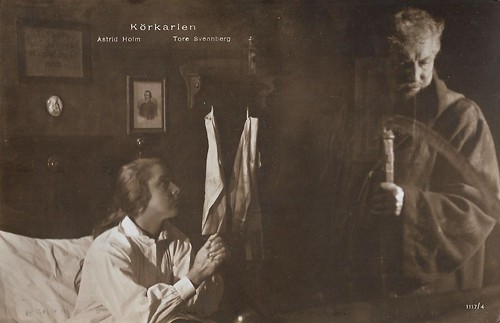
Swedish postcard by Förlag Nordisk Konst, Stockholm, no. 1117/4. Photo: Svensk Filmindustri. Astrid Holm and Tore Svennberg in Körkarlen/The Phantom Carriage (Victor Sjöström, 1921).
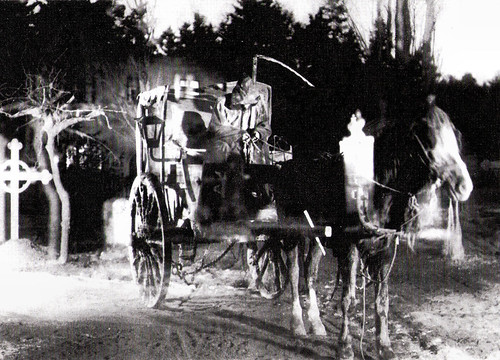
Italian programme card for Il Cinema Ritrovata 2003. Photo: publicity still for Körkarlen/The Phantom Carriage (Victor Sjöström, 1921).
Intensive use of special effects
As early as 1917, A-B Svenska Biografteater, whose merger with Filmindustri AB Scandia created AB Svensk Filmindustri in 1919, had signed a contract with Selma Lagerlöf to bring one of her works to the screen each year. In 1920, Victor Sjöström had already filmed three novels since the contract was signed: Tösen från Stormyrtorpet/The Girl from the Marsh Croft (Victor Sjöström, 1917), Ingmarssönerna/Sons of Ingmar (1919) and Karin Ingmarsdotter/God's Way/Karin Daughter of Ingmar (1920). The latter two were both based on chapters of Lagerlöf's novel 'Jerusalem' (1901-1902), about religious emigrants from Sweden to Palestine. Lagerlöf would win the Nobel Prize for Literature for 'Jerusalem'. Victor Sjöström's film adaptations had been consistently well received by critics, audiences and Lagerlöf herself.
Since the productions had all been set in rural surroundings, Sjöström chose the urban-themed novella 'Körkarlen' (Thy Soul Shall Bear Witness!) as his new project, Körkarlen/The Phantom Carriage (1921). Filming took place at Filmstaden Studios in Solna between May and July 1920. The studio buildings were inspired by the southern Swedish town of Landskrona. Lagerlöf originally wanted to have the film shot on location in Landskrona, but Sjöström decided on a studio production due to the technical possibilities.
The post-production turned out to be an unusually elaborate affair for cinematographer Julius Jaenzon and lab supervisor Eugén Hellman due to the intensive use of special effects. Jaenzon had previously worked with double exposure in Herr Arnes pengar/Sir Arne's Treasure (Mauritz Stiller, 1919), another Lagerlöf adaptation in which Victor Sjöström was not involved, but in this case, several image layers were superimposed. In this way, it was made possible for the ghost figures to move in the picture in three-dimensional space. As soon as they stood in front of a solid object, it shone through the transparent body. This technical achievement must be rated all the more highly because it must be remembered that the cameras in use at the time were still operated with hand cranks.
Körkarlen/The Phantom Carriage (Victor Sjöström, 1920) premiered at 1 January 1921, New Year's Eve. It was a success at the time and is now seen as one of the classics of Swedish silent cinema. In the Lexicon des internationalen Films, Josef Nagel reviewed the film as follows: "An impressive cinematic 'eerie ballad' based on the novel by Selma Lagerlöf. Within the complex narrative and flashback structure, mystical elements meet realistic scenes that denounce social ills resulting from industrialisation. Thanks to great emotional moments, the film unfolds in an atmospherically dense way despite its rather pedagogical, didactic message."
The film had a lasting influence on the work of Ingmar Bergman, who used the character of Death in Det sjunde inseglet/The Seventh Seal (1957) and created a direct reference to the carter of Körkarlen/The Phantom Carriage (1921) by titling him "disciplinarian." In addition, Bergman enlisted Sjöström to star in Smultronstället/Wild Strawberries (1957). It was his final role. Bergman once reported that he had first watched Körkarlen at the age of 15 and every year since. In 2000, Ingmar Bergman made the TV drama Bildmakarna/The Image Makers (2000), which fictionalised the story of the making of Körkarlen/The Phantom Carriage (1920) with Anita Björk as Selma Lagerlöf and Lennart Hjulström as Victor Sjöström.
Remakes were directed by Julien Duvivier, La charrette fantôme/The Phantom Carriage (1939) starring Pierre Fresnay and Marie Bell, and by Arne Mattsson Körkarlen/The Phantom Carriage (1958) with George Fant, Ulla Jacobsson and Anita Björk. In 2012, Körkarlen/The Phantom Carriage (1921) was named the best Swedish film of all time by 50 film critics and connoisseurs in a poll conducted by the Swedish film magazine FLM.

Swedish postcard by Förlag Nordisk Konst, Stockholm, no. 1117/6. Photo: Svensk Filmindustri.Victor Sjöström and Tore Svennberg in Körkarlen/The Phantom Carriage, (Victor Sjöström, 1921).
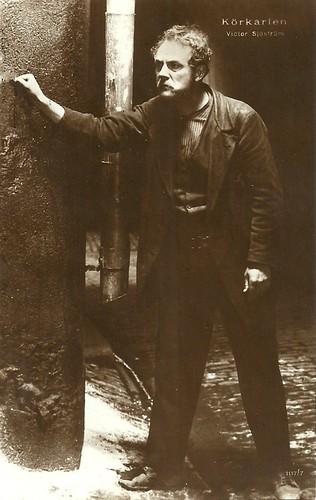
Swedish postcard by Förlag Nordisk Konst, Stockholm, no. 1117/7. Photo: Svensk Filmindustri. Victor Sjöström in Körkarlen/The Phantom Carriage, (Victor Sjöström, 1921).

French postcard by Editions Cinémagazine, no. 146. Victor Sjöström.
Sources: Wikipedia (German and English), and IMDb.
No comments:
Post a Comment